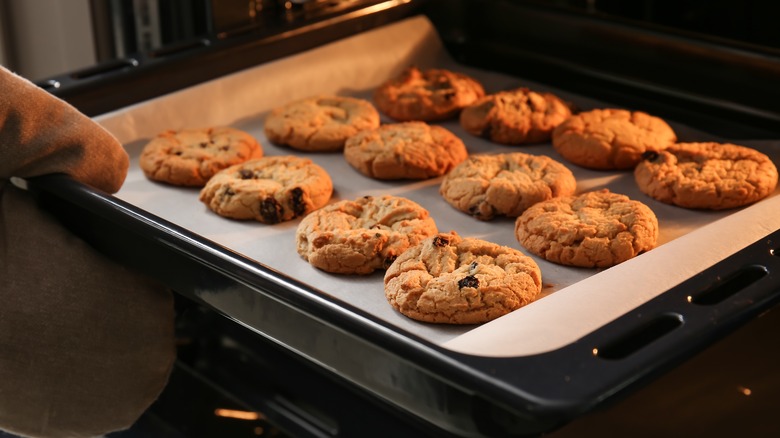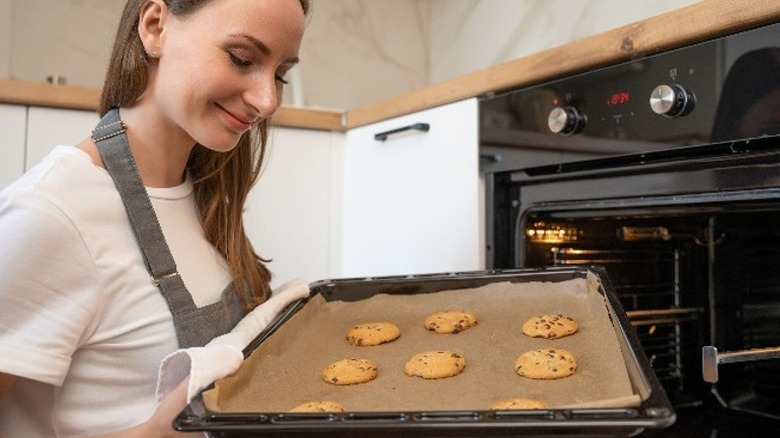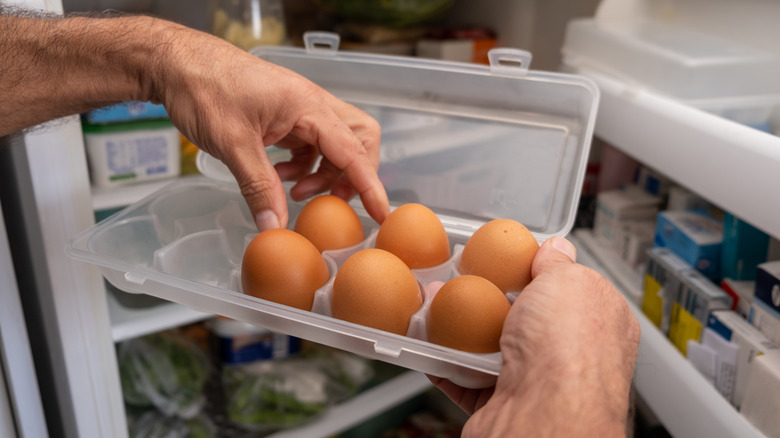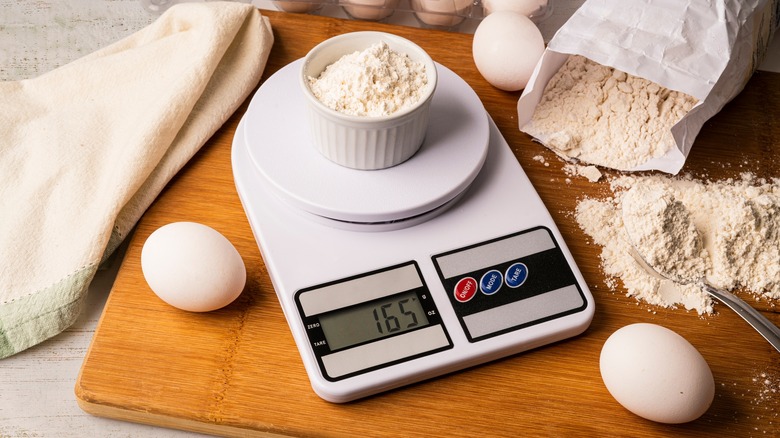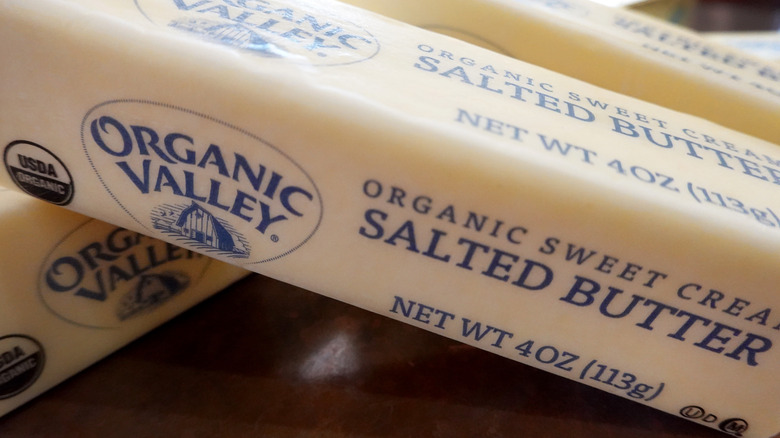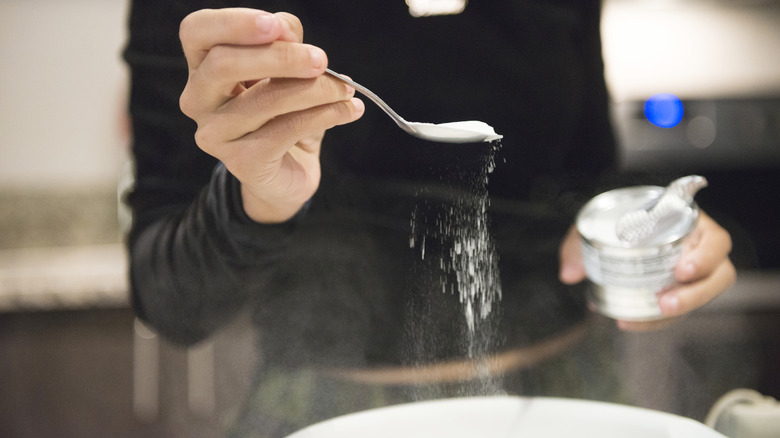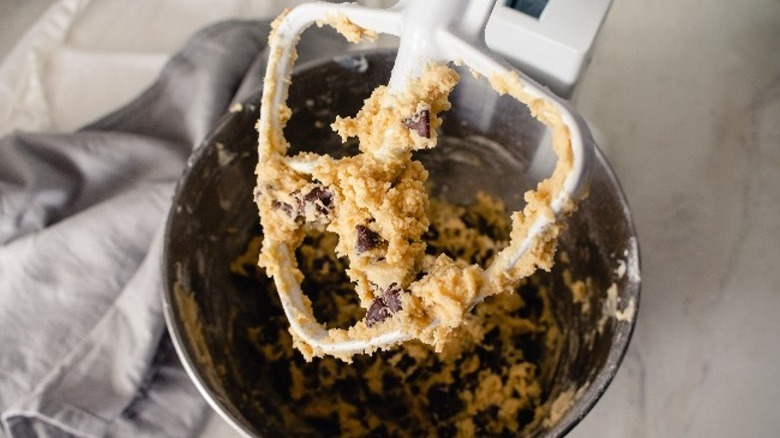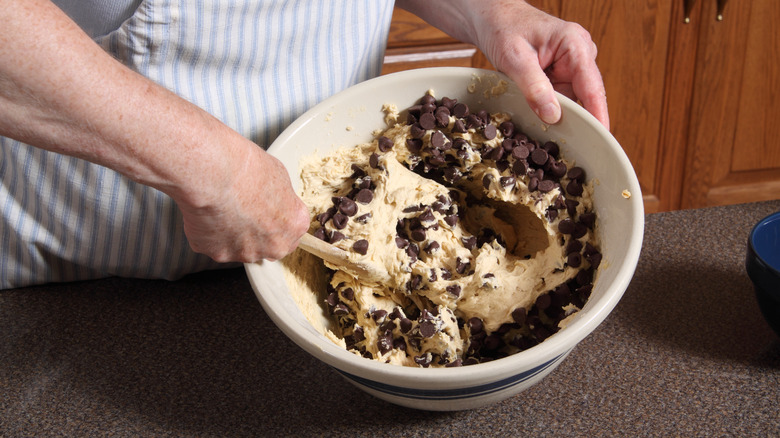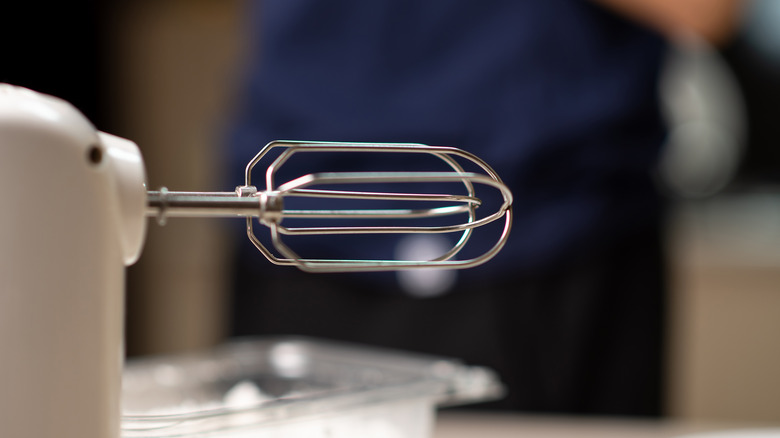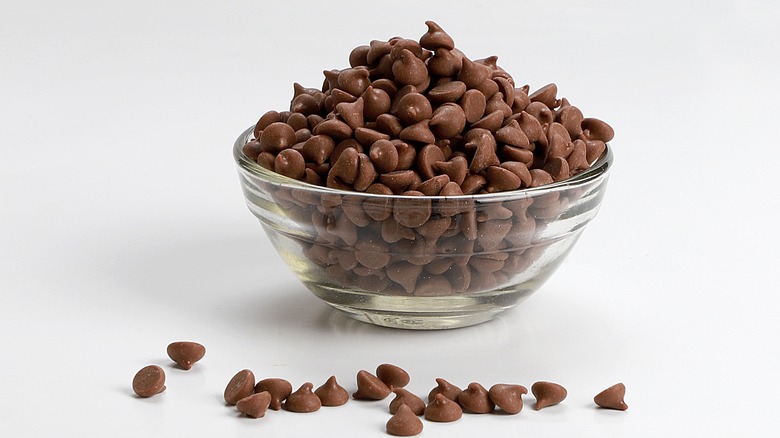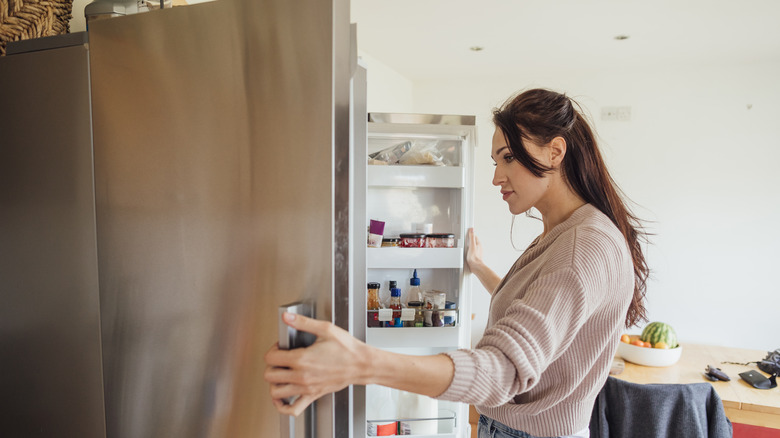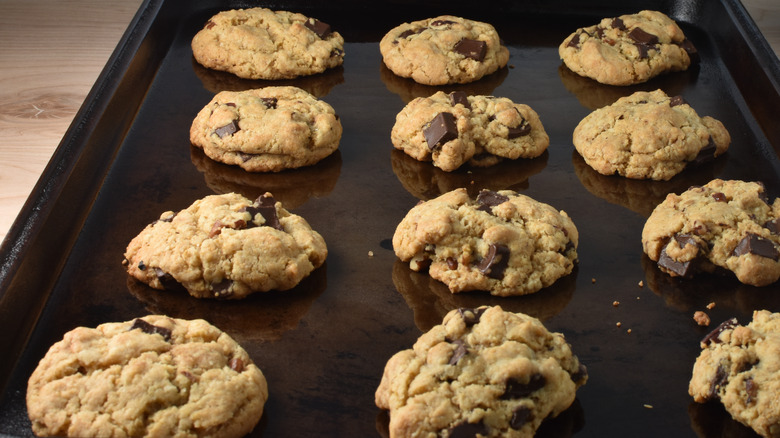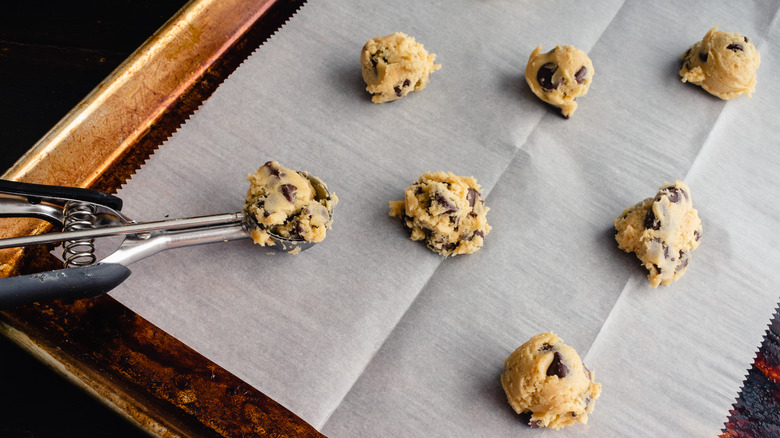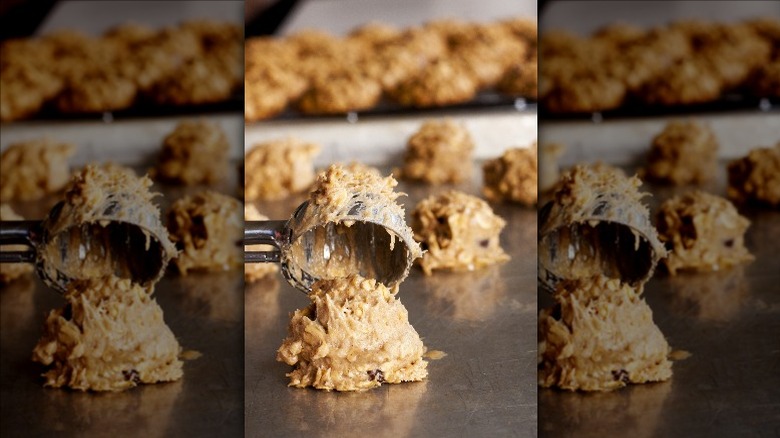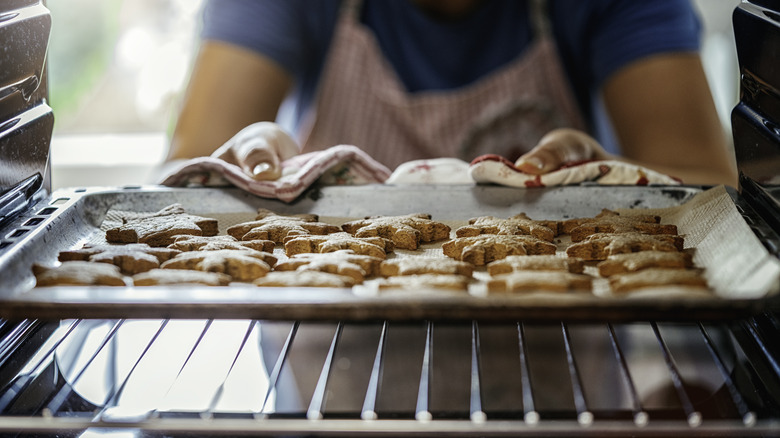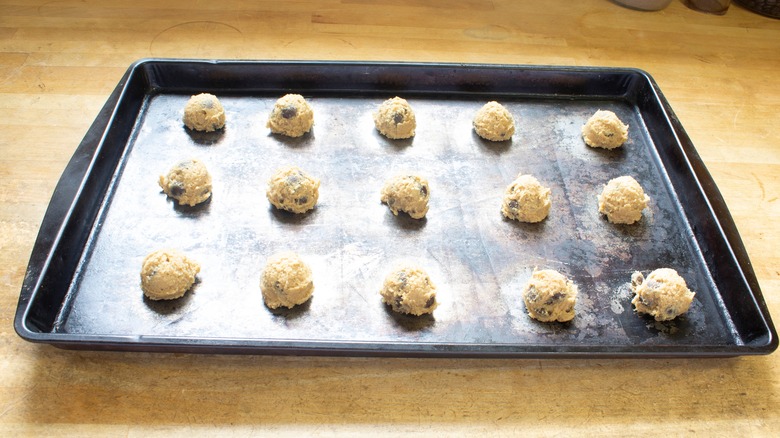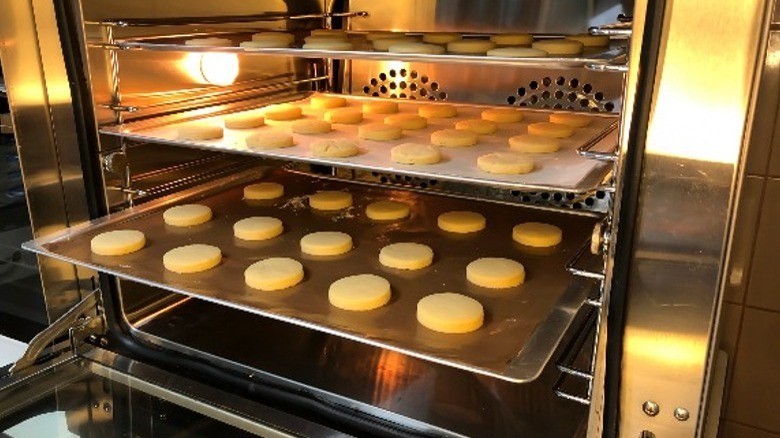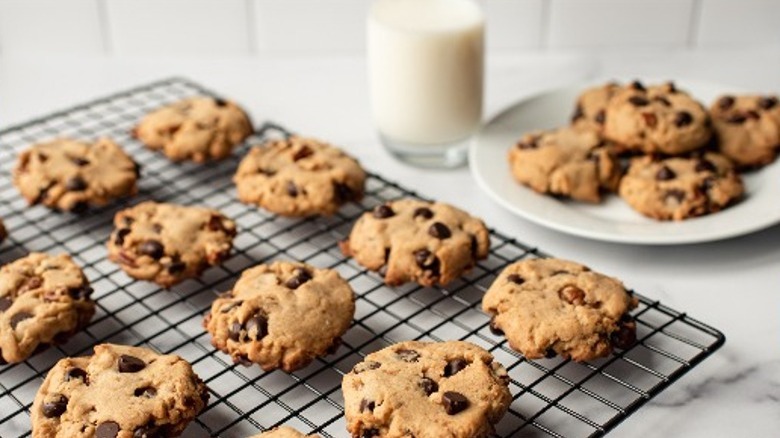19 Mistakes To Avoid When Making Chocolate Chip Cookies
Whether you're doing some holiday baking, hosting friends and family, or craving something sweet, you can't go wrong with chocolate chip cookies. There is just something incredible about biting into the rich and creamy chocolate morsels in these cookies. While many people have experience making them, many of these same people are also making mistakes when preparing a batch of these cookies.
If you want to ensure that your chocolate chip cookies are baked to perfection, avoiding these common errors is essential. Otherwise, they could turn out too runny, too crispy, or even burnt. These mistakes could even negatively impact their flavor, even your health. Take a few minutes to make sure you know how to make a delicious batch of cookies without making any of these blunders.
1. Not rotating your baking pans
When you make chocolate chip cookies, do you rotate the baking pans as they are cooking? Failing to rotate the pans about midway through the baking time can result in unevenly baked cookies.
Because ovens don't always evenly distribute heat, half of the cookies may be slightly underdone, while the other half turns out dry or even slightly burnt on the bottom. You should rotate the pans 180 degrees — so that your back row of cookies is now your front row — around the halfway point of your baking time to avoid this problem and make sure the entire batch turns out perfectly.
2. Using cold eggs
If you've been pulling your eggs directly out of the fridge and immediately cracking them into your cookie batter, you've been making a mistake. When you add cold eggs to cookie batter, they aren't going to allow the batter to blend smoothly, leaving it a little lumpy. Moreover, cold eggs can impact the texture of your cookies and can also cause them to take longer to bake.
The next time you want to make a batch of cookies, plan ahead and pull the eggs out of the fridge about an hour before you want to start mixing the batter. This will allow them to come to room temperature to ensure your cookies come out as desired.
3. Not properly measuring the flour
Did you know that there is a right way and a wrong way to measure flour? If you're not measuring your flour correctly, it can seriously impact how your cookies turn out. If you don't add enough flour to your mixing bowl, the chocolate chip cookies may turn out too thin and crispy. On the other hand, if you add too much flour, it can make the cookies too dry and fluffy.
Adding the precise amount of flour called for in the recipe is important. The best way to do this is to use a kitchen scale to weigh the flour (1 cup of flour weighs 4 and a half ounces). If you do not have a kitchen scale, the next best thing is to use a fork to break up your flour before putting it in your measuring cup. This will help prevent it from being too packed down. After you fill the measuring cup, use a level tool or the dull end of a knife to remove the excess flour from the top of the cup.
4. Forgetting to soften the butter
You likely know that you can't simply pull a stick of butter out of the fridge and toss it into your mixing bowl when making chocolate chip cookies. However, do you know the right way to soften it to help make sure your cookies turn out properly?
Many people assume that softening butter means nearly melting it, but this just isn't the case. You need the butter to have some give, but it should not be melted. If your butter ends up too warm or fully melted, then whipping it won't result in the air pockets that are necessary to ensure that cookies have a nice and even texture. Aim to take your butter out of the fridge about one hour before you plan to make your cookies — you can take it and the eggs out at the same time.
5. Using old baking soda or baking powder
Some things in your pantry can be used well past their expiration dates without any real consequences. However, baking soda and baking powder are two exceptions to the rule.
Once expired, these powders are not going to react as intended when the cookies are baking. This reaction is a crucial part of the baking process. Without it, they won't spread properly, leaving the cookies overly dense. Baking powder and baking soda are relatively inexpensive, so be sure to pick up new containers before making a batch of cookies. Toss the old baking powder, but hold on to the baking soda for cleaning-related tasks.
6. Adding all the ingredients to the bowl at the same time
If you've read a chocolate chip cookie recipe before, then you already know that these recipes require that you add ingredients to the bowl in a very specific order. Between some of these additions, you're supposed to mix some of the ingredients together. For example, you should cream the butter and sugar before adding the eggs, and mix in the eggs before adding the flour. Recipes have step-by-step directions for a reason.
If you add all the ingredients to the bowl at the same time or out of order, the cookies aren't going to turn out right. Their texture is likely to be way off — they might even have a few clumps within them. Take a few extra seconds to closely read the recipe and add the ingredients in the correct order to avoid this problem.
7. Not fully incorporating all of the ingredients
Just as it is important to make sure you add the ingredients in the right order, it is also important to make sure that they are fully incorporated before dropping the cookies onto your baking pan. When mixing, sometimes a chunk of butter or flour may be left on the bottom of the bowl.
If you don't catch that it isn't mixed in with the rest of the dough before you start baking, the texture of the cookies is going to be off. Use a scraper to move the batter around and make sure that there aren't any unmixed ingredients.
8. Overmixing the cookie batter
Don't take the recommendation to check for unmixed ingredients as a license to go crazy mixing your cookie dough. This is also a mistake. If the dough is overmixed, it's going to result in it being more fluid than normal. This means that when you go to bake your cookies, they're likely to spread out a lot more over the baking sheet. The cookies may crowd into one another, or end up much thinner and crispier than desired.
Mix enough to fully incorporate the ingredients, but make sure that you avoid overdoing it. Your arm and hand will also likely thank you for the decreased workload.
9. Not adding in enough chocolate chips
Have you ever bitten into a chocolate chip cookie only to be disappointed that you didn't taste any chocolate? Don't make the mistake of not adding enough chocolate chip cookies when making your next batch.
When you don't have enough chocolate chips, or seem to run out when you're getting to the end of the batter, your cookies are going to be disappointing. Most recipes call for a 12-ounce bag of chocolate chips. Make sure you use at least that much, but you could even consider sprinkling a few more into the dough for an even more decadent cookie.
10. Forgetting to chill the dough before baking
Once you've finished mixing your cookie dough, you don't want to immediately scoop it onto your cookie sheet to start baking. The cookies will turn out better if you give the dough time to chill in the fridge. When the dough is allowed to rest, the dry ingredients will have sufficient time to really soak up the eggs, butter, vanilla, and other wet ingredients. This will help firm up the dough to yield nice and chewy cookies.
In a perfect world, chocolate chip cookie dough should chill for 24 to 36 hours. However, this often isn't realistic, so try to make sure you give your dough at least one or two hours to chill before baking the cookies.
11. Baking the cookies on a pan that is too dark
While you may assume that any baking sheet will deliver the same results when used for baking cookies, that is not the case. Choosing a baking sheet that is dark is a mistake that can have a negative impact on how your cookies turn out.
A dark baking sheet will absorb more heat than a lighter-colored one. Because the pan is hotter, the base of the cookies will cook more quickly than the rest of them. Your cookies won't cook evenly, and it is much more likely that the bottom will burn. If you only have dark barking sheets, decrease the recommended oven temperature by about 25 degrees to try to combat the over-browning. Lining the baking sheet with parchment paper may also help to decrease the impact of using a darker pan.
12. Not properly spacing the cookies
Proper placement of your cookies on the baking sheet is also important. If you place them too closely together, they are likely going to spread into each other as they bake.
Think about the process of making cookies. When you drop the dough on the cookie sheet, it is a rather formed and compact ball. However, once the dough starts heating up in the oven, it spreads out. Without sufficient space, it will run into the other cookies, the edge of the plate, or even off of flat cookie sheets and onto your oven racks. You shouldn't try to fit more than a dozen cookies on a standard-size cookie sheet.
13. Scooping out unevenly sized cookies
Another mistake that people make is not dropping evenly-sized balls of cookie dough on their baking sheets. If some balls have more dough than others, they are going to require a longer baking time. So, either some of your cookies will end up underdone, or some will end up overdone.
Don't just eyeball it and hope it all works out OK. The best way to ensure that all of the cookie dough balls are the same size is to use a cookie scoop. You could also use the edge of a spoon if you don't have a scoop.
14. Placing the rack too high or too low in the oven
Before putting your baking sheet of cookies into the oven or (even better) before preheating it, pay attention to where the rack is. If you recently used the broiler and have the rack towards the top of the oven or cooked a large roast with the rack nearly all the way down, you'll likely need to move it before baking your cookies.
This is because the best spot to put the rack is in the center. With this placement, plenty of air will be able to circulate around it and the cookies will bake more evenly.
15. Using a cookie sheet that is already hot
When you make cookies, do you drop more dough on the baking sheets immediately after moving the cookies to the cooling rack? If so, you've identified another mistake you should work to remedy. Dropping cookies onto a hot cookie sheet — even one that is only slightly warm — can make them spread immediately. This will result in much flatter cookies than are desired.
You'll either want to have multiple cookie sheets to cycle through while baking or make sure the one you are using cools completely. You can help the hot sheet to cool more quickly by placing it in the refrigerator, leaving it outside on a cooler day, or running cold water over the pan's underside.
16. Assuming that the recipe's baking time is correct
If you read the bake time listed on the cookie recipe you're making, set a timer, and remove the cookies when the timer goes off, then you're making a mistake. The bake times listed on a recipe will not always be 100% accurate. The way one oven heats and bakes can vary from how another operates. Plus, the thermostat on many ovens is off and may read either hotter or cooler than it actually is.
Using an oven thermometer can help you verify that your oven is heating correctly. However, even if you do, you should still check your cookies a few minutes before the suggested bake time has passed. Don't be surprised if they end up taking a bit longer to bake than the high end of the time range.
17. Opening the oven too much during baking
If you want to check on your cookies to see how they're progressing, there is a right way and a wrong way to do so. The right way is to turn on the oven light and look through the glass on the door. The wrong way is to open the oven door to take a peek.
Every time you open the door to the oven, you're letting heat out. Even slight temperature changes will impact the baking process. Do everything you can to avoid opening the oven while cookies — or anything else — are cooking or baking.
18. Transferring the cookies to the cooling rack immediately
Don't immediately move your cookies from the cookie sheet to the cooling rack after taking them out of the oven. When cookies first come out of the oven, they're going to be very soft. Trying to move them right away can cause them to break.
About one minute of cooling on the cookie sheet should be enough for the cookies to set before moving them to the cooling rack. Moving them after just a minute should yield a crispier cookie. However, if you prefer chewier cookies, give them a few additional minutes to sit on the cookie sheet before transferring them to the rack.
19. Sampling the raw cookie dough
Tasting raw cookie dough isn't a good idea — even if it was a tradition when you were growing up. Between the raw eggs and raw flour in the dough, eating it may result in food poisoning. There may be germs such as E. coli or salmonella in the raw ingredients.
Fortunately, cooking the dough will kill these germs, so the finished cookies will be safe to eat. However, the raw dough is not. Resist the urge to taste the cookie dough and just wait for the cookies to finish baking. They'll be delicious and worth the wait; don't worry.
